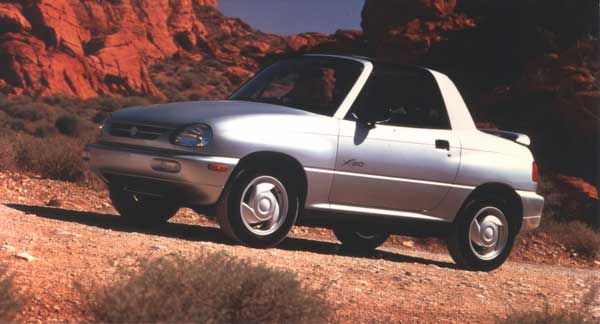DOOMED TO FAIL: WHEN MANUFACTURERS GOT IT WRONG
Automotive history is full of failures, but while manufacturers often learn from their mistakes, that hasn’t stopped them occasionally developing a vehicle the market wasn’t quite ready for.
In this list, Footman James looks back on seven vehicles that lost their way, either because buyers misunderstood them, manufacturers suffered production setbacks, or they were just plain wrong from the beginning.
BMW C1

Image credit - BMW AG
Introduced in 2000 and built by Bertone in Italy, BMW Motorrad had high hopes for its C1 scooter, and believed the concept would work in damp climates such as ours. The partially enclosed cabin shielded riders from most of the rain, but its single-seater design left no room for a pillion. It was safe, though. BMW said it offered similar protection to a supermini in a head-on crash, thanks to a crumple zone, roll cage and a three-point seatbelt. The UK and Sweden were the only countries not to grant scooterists permission to ride without a helmet, and poor sales killed the C1 after just two years.
DeLorean DMC-12

Image credit - Bridge of Weir
Thanks to the Back to The Future trilogy, the DeLorean DMC-12 will always be regarded as an icon. But, rushed to market and dogged by production issues, it flopped after two short years. John DeLorean’s DMC-12 was powered by a 2.85-litre V6 ‘PRV’ engine that was partly to blame for its disappointing driving experience. Poor build quality, a high return rate, industrial disruption, recession and financial problems all plagued John’s dream of running his own car company. Desperate efforts to raise funds followed, and he was arrested on drug trafficking charges.
Renault Avantime

Image credit – Renault
French manufacturer Matra Automobiles already had a relationship with Renault, building the successful Espace thanks to its specialism in composite bodywork, and in 2001, the pair launched the Avantime. It featured a mix of design elements aimed at attracting the grown-up children of Espace owners, blending the space of an MPV with the appearance of a coupe. It was certainly striking to look at and still is today, but only 8,557 found buyers. Matra suffered financial losses and was forced to close its factory, leading to Renault’s decision to end production altogether, rather than move it elsewhere.
Suzuki X-90

Image credit - Suzuki Motor Corporation
The Suzuki X-90, a two-seater, open-topped 4x4 on sale between 1995-97 was famously described by Jeremy Clarkson as the ‘worst car ever.’ Maybe that’s because it wasn’t designed primarily for Europeans or even the Japanese. Instead, Suzuki had the American market in mind, believing they saw cars as a form of personal expression. Despite being well specified, attractively priced, well built, and with a choice of front or four-wheel drive, buyers in all markets just could not get on with the looks.
Matra Rancho

Matra appears in our list for a second time, offering France’s first SUV attempt. Then under Chrysler ownership and buoyed by the reception to the Matra Bagheera, the company wanted to continue its innovative streak. Taking inspiration from the Range Rover but with a desire to make something cheaper, the Rancho was intended to serve outdoorsy customers who had a ‘zest for life.’ Sadly, though, the spotlights, black wheel arch extensions, large windows and practical design were not enough to interest buyers once they learned there was no 4x4 version, and production ended in 1984 after just seven years. Today, it’s a rare but revered beast.
Rover 800 Coupe

The Rover 800 Coupe was originally intended for the American market under the firm’s Sterling marque. Unfortunately, despite a joint venture with Honda, the US perception of British build quality and reliability persisted, and Sterling was placed near the bottom of America’s J.D. Power Initial Quality Study. Rover quality improvements weren’t enough, and sales never recovered, forcing the company to leave the US market in 1991 just as the 800 Coupe was due to be launched. The launch went ahead in Rover’s remaining markets, but despite its attractive design, sales were never going to live up to original expectations that relied on the Coupe-mad US market. In Europe, customers were eager for more desirable German rivals.
Ford ‘Granada’ Scorpio

Image credit - Ford Motor Company
The angular and imposing Mark I and Mark II Ford Granada gained a ‘bad boy’ image, thanks to TV shows such as The Professionals and The Sweeney. But in 13 short years, the Mark III Granada, badged as the Scorpio in Europe, had become a smoothly styled, futuristic and inoffensive design, advertised at middle-class businessmen. Ford had forgotten the lessons of the launch of the ‘jellymould’ Sierra three years previously, and the Granada was initially only available as a hatchback. The European Car of the Year title, standard-fit ABS and a great driving position did little to secure the Granada’s future. Ford inflicted further damage with the heavily facelifted ‘frog-eyed’ Scorpio in 1994, and this was the final nail in the coffin for Ford’s executive saloon. It was axed altogether four years later.
The Sinclair C5 was another commercial failure. Can you think of any others? Maybe you’ve even owned a few. Tell us about them in the comments below.
As regards the Granada - the nail in the coffin was actually Fords purchase of Jaguar/Landrover. It was decided by Ford's management that the Granada would be competition to the JLR range and wS discontinued. The same fate befell the Euro version of the Explorer.
Neil, 14/04/2023

You need to remember that there is no 'perfect' car - each and every new model being some compromise of nameplate reputation, manufacture, marketing, distribution and customer acceptance. The automotive industry has long suffered from poor operating margins and each operational slip places the vehicle in jeopardy. In many cases (e.g., Avantine) the purpose may be largely un-noticed; Renault were wishing to display their outermost design and technological capabilities and it was therefore perfectly acceptable for the car to be a money-pit to make which was impractical for all retail car buyers - but still got the point across. In the case of the Rancho, Chrysler for a change saw a large market niche which enabled a large community of buyers to be Range Rover look-alikes and just like that formidable R-R community did not understand what 4-wheel drive was for and never went off-road. Their unique 2-wheel Grip system survives today on Peugeot group front wheel drives including their van range.
Mike Wattam, 14/04/2023